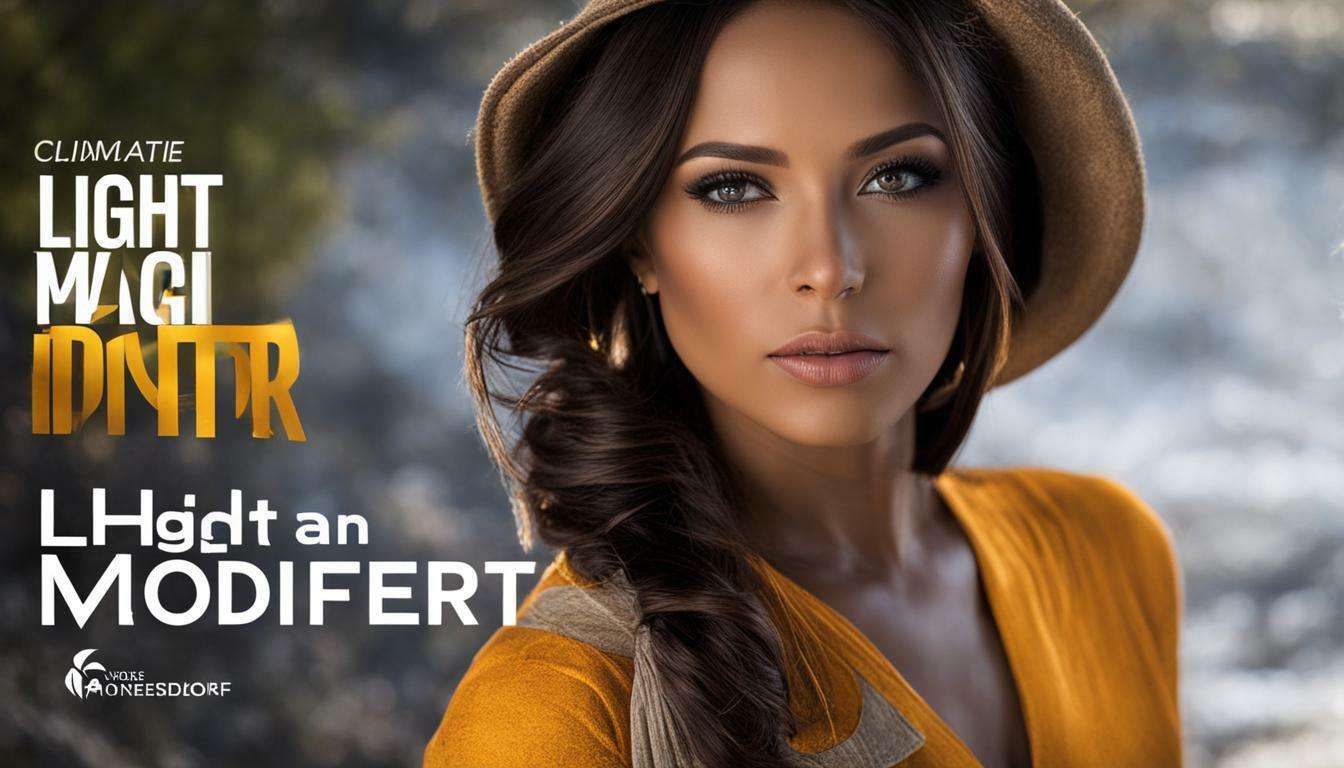Light modifiers are essential tools that photographers use to manipulate and optimize lighting conditions for capturing stunning images. These modifiers allow photographers to have greater control over the intensity, direction, and quality of light, enabling them to create the desired mood, atmosphere, and exposure in their photographs. Whether it’s softening harsh shadows, spreading light evenly, altering the color temperature, or shaping and directing light, light modifiers play a crucial role in enhancing the overall lighting setup and techniques in photography.
Key Takeaways:
- Light modifiers are tools used in photography to manipulate and control lighting conditions.
- Common types of light modifiers include diffusers, softboxes, umbrellas, grids, gels, barn doors, and reflectors.
- Diffusers and softboxes are used to create soft and natural-looking lighting.
- Umbrellas are versatile light modifiers that create a broad and even light source.
- Grids help control and direct the spread of light for more precise lighting effects.
Understanding Different Types of Light Modifiers
There is a wide range of light modifiers available, each designed to achieve specific lighting effects and enhance the overall quality of the image. These light modifiers can be essential tools for photographers and filmmakers who want to have full control over their lighting setups. Let’s explore some of the most common types of light modifiers and their unique characteristics:
- Diffusers: Diffusers are used to spread light and soften shadows. They help create a more even and flattering lighting by reducing harsh contrasts. Common diffusers include panels made of fabric or translucent materials like silk or diffuser paper.
- Softboxes: Softboxes are light modifiers that produce soft and natural-looking light. They consist of a box-shaped enclosure lined with a reflective interior and covered with a diffusing material. The size and shape of softboxes can be varied to control the spread and intensity of the light.
- Umbrellas: Umbrellas are versatile light modifiers that can be used both indoors and outdoors. They create a broad and even light source, making them ideal for portrait and product photography. Reflective umbrellas bounce light back onto the subject, while shoot-through umbrellas allow light to pass through the translucent material.
“Diffusers spread light and soften shadows, while softboxes create soft and natural-looking light. Umbrellas are versatile and can be used to create a broad and even light source.” – Professional Photographer
In addition to diffusers, softboxes, and umbrellas, photographers and filmmakers can also make use of other light modifiers such as grids, gels, barn doors, and reflectors.
Grids:
Grids are used to control and direct the light, allowing for more precise lighting effects. They consist of a honeycomb-like structure that attaches to the front of a light source. Grids help to reduce light spill and create more focused and directional lighting.
Gels and Barn Doors:
Gels are color filters that alter the color temperature of the light. They can be used to correct the color temperature of artificial lighting or to create dramatic lighting effects. Barn doors, on the other hand, are adjustable flaps that can be attached to a light source to shape and direct the light. They are particularly useful for controlling the spread of light and creating specific lighting patterns.
Reflectors are another important light modifier that bounces light back onto the subject. They can be used to fill in shadows, enhance natural lighting, and provide additional control over the lighting situation. Reflectors are available in various shapes and sizes, with different surface finishes to create the desired lighting effect.
When using light modifiers, it’s important to consider the size and shape of the light source, the distance, and the desired mood or atmosphere. Experimentation and practice are key to mastering the use of light modifiers and achieving the desired lighting effects.
| Light Modifier | Function |
|---|---|
| Diffusers | Spread light, soften shadows |
| Softboxes | Create soft, natural-looking light |
| Umbrellas | Create broad, even light source |
| Grids | Control and direct light |
| Gels | Alter color temperature of light |
| Barn Doors | Shape and direct light |
| Reflectors | Bounce light back onto subject |
Using Diffusers and Softboxes for Soft and Natural Lighting
Diffusers and softboxes are essential tools for photographers looking to achieve soft and natural lighting in their indoor shots. These light modifiers help eliminate harsh shadows and create a pleasing, even light source. By spreading and softening the light, diffusers and softboxes produce a gentle and flattering illumination that enhances the subject.
Diffusers work by scattering the light, which reduces the intensity and creates a more diffused and even illumination. They can be attached directly to the light source or placed in front of it. Softboxes, on the other hand, consist of a box-shaped structure with a diffusing material covering the front. They create a larger light source, resulting in softer and more natural-looking light.
When using diffusers and softboxes, it’s important to consider the size and shape of the light source, the distance between the subject and the light, and the desired mood or atmosphere. Larger diffusers and softboxes tend to produce softer light, while smaller ones create more directional and focused illumination. Experimentation and practice are key to mastering the use of these light modifiers and achieving the desired lighting effects.
Tips for Using Diffusers and Softboxes:
- Place the diffuser or softbox close to the subject for softer light.
- Experiment with different sizes and shapes to achieve the desired lighting effect.
- Combine diffusers and softboxes with other light modifiers for more creative control.
- Adjust the distance and angle of the light source to vary the intensity and direction of the light.
“Diffusers and softboxes are like magic wands in the hands of photographers. With these tools, you can transform harsh lighting into soft, enchanting illumination that brings out the best in your subjects.” – Professional Photographer
In conclusion, diffusers and softboxes are versatile light modifiers that allow photographers to achieve soft and natural lighting in their indoor shots. By using these tools effectively and experimenting with different techniques, photographers can enhance their images and create a desired mood or atmosphere. So, don’t be afraid to explore the world of diffusers and softboxes and unlock the full potential of your photography!
| Light Modifier | Function |
|---|---|
| Diffuser | Spreads and softens light, reduces harsh shadows. |
| Softbox | Creates a large, soft light source for natural-looking illumination. |
Creating Versatile Lighting with Umbrellas and Grids
Umbrellas and grids are invaluable modifiers that offer versatility in outdoor photography, enabling photographers to achieve a wide range of lighting setups and effects. These modifiers play a crucial role in controlling the direction, spread, and intensity of light, allowing for precise lighting control in various shooting conditions.
Umbrellas: One of the most popular light modifiers, umbrellas create a broad and even light source, making them ideal for outdoor photography. They come in different sizes and materials, with white and silver options available. White umbrellas produce soft and diffused light, while silver umbrellas create more intense and focused lighting. By adjusting the distance between the umbrella and the subject, photographers can control the intensity and spread of the light. Additionally, umbrellas can be used as a primary light source or as a fill light to soften shadows and create a more balanced exposure.
Grids: Grids are essential for controlling the direction and spread of light. These mesh-like attachments are designed to be placed in front of the light source, narrowing the beam and creating a more focused and controlled spill of light. Grids are particularly useful when photographers need to isolate specific areas or subjects within a scene. They can be combined with umbrellas to limit light spill and achieve more controlled and dramatic lighting effects. With grids, photographers have the flexibility to shape their lighting precisely, enhancing the overall composition and visual impact of their images.
To maximize the benefits of umbrellas and grids, photographers should consider the size and shape of the light source, the distance between the modifier and the subject, and the desired mood or atmosphere. Experimentation and practice are key to mastering the use of these modifiers and achieving the desired lighting effects. By understanding the unique characteristics of umbrellas and grids, photographers can unleash their creativity and take their outdoor photography to new heights.
Altering Light with Gels and Barn Doors
Gels and barn doors are powerful tools that allow photographers to manipulate and modify artificial lighting to achieve desired creative effects. Gels, thin sheets of transparent material, are placed in front of the light source to alter the color temperature of the light. Whether you want to create a warm, golden glow or a cool, blue tint, gels can help you achieve the desired mood or atmosphere for your photos. By experimenting with different colors, photographers can add depth and emotion to their images.
Barn doors, on the other hand, are adjustable flaps attached to the front of the light source. They are used to shape and direct the light, allowing photographers to control and focus the illumination on specific areas. By adjusting the angle and position of the barn doors, photographers can create dramatic lighting effects, such as spotlighting or backlighting. Barn doors are particularly useful in portrait photography, as they can help highlight the subject’s features or create interesting patterns and shadows.
Using Gels and Barn Doors Together
When used in combination, gels and barn doors offer photographers even greater creative control over their lighting setups. By attaching gels to the barn doors, photographers can modify both the color temperature and direction of the light simultaneously, resulting in unique and impactful images. This combination can be especially effective in creating dynamic and visually striking portraits or adding a dramatic flair to commercial or fashion photography.
| Gels | Barn Doors |
|---|---|
| Alters color temperature | Shapes and directs light |
| Adds mood and atmosphere | Controls illumination on specific areas |
| Creates depth and emotion | Highlights subject’s features |
Ultimately, the use of gels and barn doors requires experimentation and practice. Photographers must consider the size and shape of the light source, the distance from the subject, and the desired outcome in order to achieve the desired creative effects. By mastering the techniques of using gels and barn doors, photographers can elevate their craft and capture images that truly stand out.
Maximizing Creative Control with Reflectors
Reflectors are essential tools in a photographer’s kit, as they provide a versatile way to manipulate and enhance natural lighting conditions. Whether shooting portraits, landscapes, or still life, reflectors offer a simple yet powerful solution to control and shape light. By bouncing light back onto the subject, reflectors can fill in shadows, soften harsh lighting, and add a subtle glow.
One of the key advantages of reflectors is their ability to modify natural light without the need for additional artificial sources. Their portable and lightweight nature makes them ideal for location shoots, allowing photographers to work with and optimize the available light. Reflectors come in various shapes and sizes, from small handheld discs to larger collapsible panels, providing flexibility depending on the shooting scenario.
When using reflectors, it’s important to consider their color and surface material. Reflectors can be silver, gold, white, or translucent, each producing a different effect on the light. Silver reflectors create a bright and contrasty light, ideal for high-contrast portraits. Gold reflectors add warmth and depth, enhancing skin tones and creating a sunny, golden-hour effect. White reflectors produce a more neutral and natural light, while translucent reflectors soften and diffuse the light, reducing harsh shadows.
To achieve the desired lighting effect, position the reflector strategically. Place it opposite the main light source to bounce back light onto the subject’s shadow side, filling in any unwanted shadows. Experiment with different angles and distances to control the intensity of the reflected light. Reflectors can also be used to redirect light for a more directional and sculpted look. By shaping the reflector or positioning it at a certain angle, photographers can create interesting highlights and contours on their subjects.
Ultimately, mastering the use of reflectors requires practice and experimentation. Understanding the properties of light and how reflectors can manipulate and enhance it is crucial for achieving the desired mood and atmosphere in your photographs. So, grab your reflector, head out into nature or set up a studio session, and start exploring the endless possibilities that reflectors offer in maximizing your creative control over natural lighting.
| Reflectors | Color | Surface Material | Effect |
|---|---|---|---|
| Silver | Silver | Bright and contrasty light | |
| Gold | Gold | Warmth and depth, enhances skin tones | |
| White | White | Neutral and natural light | |
| Translucent | Translucent | Softens and diffuses light, reduces harsh shadows |
Conclusion
Mastering the use of light modifiers is crucial for photographers seeking to optimize lighting and exposure in their images, allowing for greater creative control and enhanced image quality. Light modifiers are versatile tools that manipulate the characteristics of light to achieve desired effects. Whether it’s diffusers, softboxes, umbrellas, grids, gels, barn doors, or reflectors, each type of light modifier serves a specific purpose in controlling and enhancing lighting.
Diffusers and softboxes are ideal for creating soft and natural-looking light. They spread light evenly and soften shadows, making them perfect for indoor photography. Umbrellas, on the other hand, offer versatility as they can create a broad and even light source, making them suitable for outdoor photography. Grids help control the direction and spread of light, allowing photographers to achieve precise lighting effects.
Gels and barn doors provide the ability to alter the color temperature of light and shape and direct it, respectively. Gels can be used to adjust the color temperature of artificial lighting, while barn doors help create specific lighting patterns. Reflectors, another essential light modifier, bounce light back onto the subject, filling in shadows and enhancing natural lighting.
When using light modifiers, photographers need to consider factors such as the size and shape of the light source, the distance to the subject, and the desired mood or atmosphere. Experimentation and practice are key to mastering the use of light modifiers and achieving the desired lighting effects. By understanding the different types of light modifiers and their functions, photographers can take full advantage of these tools to elevate their photography and bring their creative vision to life.
How Does the Use of Leading Lines Impact the Lighting in a Photograph?
Leading lines and creating depth play a crucial role in impacting the lighting of a photograph. By using strategically placed lines, photographers can guide the viewer’s eyes towards the main subject, often enhancing the play of light and shadow. These lines can create a sense of depth, adding visual interest and dimension to the image. Properly utilizing leading lines can result in a more dynamic and visually appealing photograph.
How Can Light Modifiers Help Me Control and Enhance Natural Lighting?
Understanding variations in natural light is crucial for controlling and enhancing it effectively. Light modifiers play a significant role in achieving this. Whether it’s diffusers, reflectors, or filters, light modifiers provide the means to manipulate and shape light, helping photographers, cinematographers, and artists achieve their desired visual effects by softening, redirecting, or altering the intensity of natural light.
FAQ
What are light modifiers?
Light modifiers are tools used by photographers and filmmakers to control and enhance lighting. They manipulate the characteristics of light to achieve desired effects.
What are some common types of light modifiers?
Some common types of light modifiers include diffusers, softboxes, umbrellas, grids, gels, barn doors, and reflectors.
What do diffusers do?
Diffusers spread light and soften shadows, creating a more flattering and natural-looking light source.
How do softboxes work?
Softboxes create soft and natural-looking light by diffusing the harshness of direct light and producing a more even light distribution.
What is the purpose of umbrellas as light modifiers?
Umbrellas are versatile modifiers that can be used to create a broad and even light source, making them ideal for outdoor photography or when a large light spread is desired.
What do grids do?
Grids help control the direction and spread of light, allowing for more precise lighting effects.
What are gels used for?
Gels are used to alter the color temperature of the light, enabling photographers to create different moods or correct for the color temperature of artificial lighting.
How do barn doors shape and direct light?
Barn doors are adjustable flaps attached to a light source that can be used to shape and direct the light, creating specific lighting patterns or preventing light spillage.
How do reflectors work as light modifiers?
Reflectors bounce light back onto the subject, filling in shadows, enhancing natural lighting, and providing additional control over the lighting situation.
What factors should be considered when using light modifiers?
When using light modifiers, it’s important to consider the size and shape of the light source, the distance between the light source and subject, and the desired mood or atmosphere.
How can one master the use of light modifiers?
Experimentation and practice are key to mastering the use of light modifiers and achieving the desired lighting effects.






